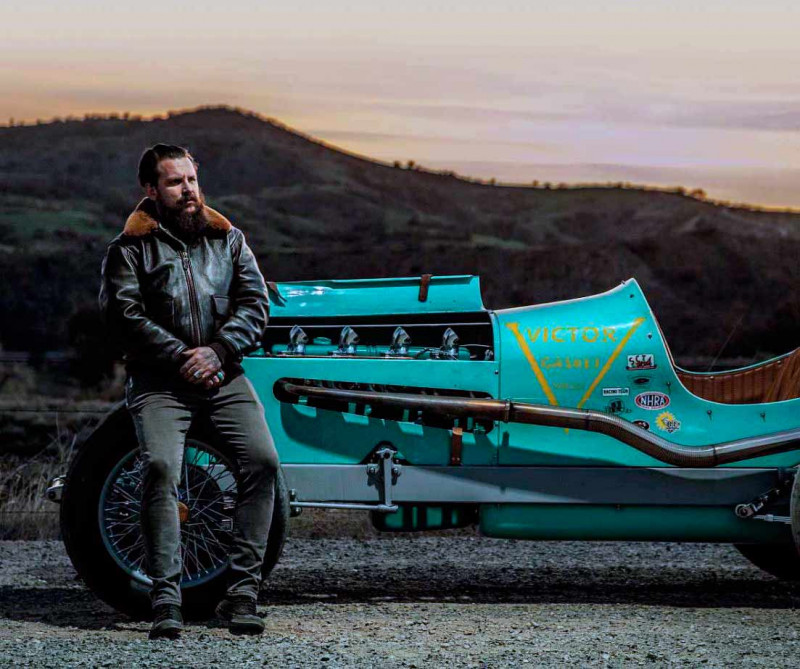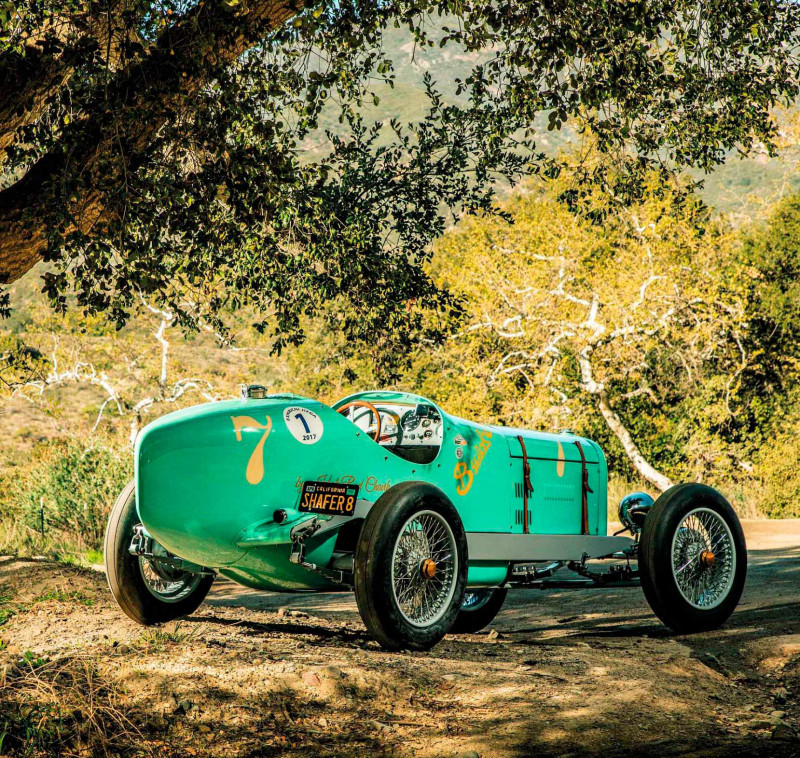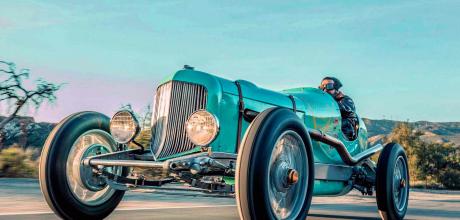Chavik Indy Roadster - Czech-built hot rod, taking So-Cal by storm
Stanley Chavik used the internet to inspire his dream rod, then used the rod to move to California from the Czech Republic. And California loves it. Words Jay Harvey. Photography Evan Klein.
WEST COAST EASTERN PROMISE
People often wonder what lasting effects the internet will have on the world. Well, here’s a car and a story that would never have happened without Google. Not so long ago, Stanislav Chavik was an anonymous welder and panel beater, spending long days in a little shop in the eastern Czech Republic customising motorcycles and hammering out Wartburg fenders and dreaming of life in the California sun. Today, Chavik wakes up every morning in the actual sunshine of Southern California and spends all day building exquisite hot rods for a line of cashed-up clientele who aren’t afraid of dropping a couple of hundred grand on a Hot-Rod Chavik USA custom build. ‘It is like God opened a gate,’ says Stanislav, who now calls himself Stanley. And it all started with a dilapidated 1939 Buick and an internet connection.

The Buick Motor Division of General Motors built 208,000 cars in 1939, of which 198,000 or so were sold in the United States. The remaining 10,000 were dispersed with their overhead-valve straight-eights to the world’s four corners like dandelion seeds on the spring winds. One of those steel dandelions finally landed in central Europe in the late 2000s, rather the worse for wear from the intervening decades. In the Czech Republic, in the little shoemaking city of Zlín, was Chavik, dreaming of American-style hot rods and tired of using his trade school education on the Eastern Bloc cars that dominated the local scene. He bought the Buick, by then not much more than a pile of parts, with vague ideas of restoring it, but life kept getting in the way.

He opened his own garage, Hot-Rod Chavik, in Zlín in 2003 and worked 65 hours a week trying to build interesting vehicles within the Czech Republic’s asphyxiating rules controlling vehicle modifications. He got a whole bunch of tattoos to relieve the stress and binged on American car movies such as Dirty Mary, Crazy Larry. His wife, Dagmar – ‘Daisy’, as she is now known – is petite and angelic, but she talks decisively and in better-lubricated English than Stanley (such that she often finishes his sentences). She presents a striking contrast to Stanley’s furry frame, which is almost as broad from the waist up as it is tall.
‘I was just a dreamer and a worker; she straightened me,’ says Stanley. ‘We did it the regular way – we married, then had a kid.’ Little Stanislav arrived in 2011, and life got even more hectic. For four years, Stanley worked like a slave and in spare moments wondered what he should do with his derelict Buick. ‘I love all the racing – the beautiful shapes and the colours.’ So, one night, he sat down at the computer, the place where he liked to escape virtually across continents and oceans to the So-Cal Speed Shop, to Mooneyes, Isky Racing Cams, Edelbrock, and to the other altars of the Southern California rod culture, and typed ‘old racer Indy’ into Google. His life was about to change.
Chavik read about Phil Shafer, who was born half a world away and more than a century earlier in Des Moines, Iowa. Shafer’s friends called him ‘Red’ because of his auburn hair, and he was 21 when he drove in his first automobile race in Iowa City. By 1929, Red Shafer ran a thriving Pontiac dealership in Des Moines and had competed on every board track and dirt patch between Indianapolis and Altoona. Doctors advised him to give up racing or risk heart failure. Instead, Shafer took two years off – a hiatus that may have had more to do with the stock market crash than his heart – and returned in 1931, tanned, rested, and ready with a fresh car for the new stock-block rules at Indianapolis. Built in Indy by Herman Rigling, one of that town’s first speed geniuses and himself a German immigrant, the Shafer 8 featured Buick’s newest 272ci overhead-valve straight-eight, powerful enough to qualify the car for the 1931 Indy 500 with an average speed of 105.103mph. Shafer and his riding mechanic, Charles Cariens, finished a respectable 12th that year and won $430 after battling their way up from 23rd.
Successions of Shafer 8s followed, sporting Buick engines and the same golden-age racer form: a tall, horse-collar grille leading to a long, cigar-shaped body atop a naked steel frame, the tiny cockpit just ahead of the wasp tail. In period photos, fleshy Firestone balloon tyres on knock-off wires sit at the corners of Shafer’s cars, while the eight short exhaust stacks feed to a single pipe slung along the left side. Chavik marvelled at the photos of the originals back in the day, plus the various recreations that have been built over the years by collectors such as Corky Coker, the vintage-tyre king of Chattanooga, Tennessee.
Chavik suddenly knew what he wanted to do with his ’39 Buick. It took him, he guesses, somewhere between 1000 and 1500 hours over ‘one hard year’, working early mornings and late nights and whenever else he could find a free minute around his day job. Only the 248ci engine, three-speed transmission, torque tube, rear axle, and rear knee-action shocks survived from the ’39 Buick. Chavik made the rest from scratch using whatever Googled photos of the real Shafer 8s and the recreations he could pull up on his desktop in Zlín. He bent the sheet-metal on a press brake and machined a replica of Shafer’s steering linkage from a chunk of iron bar stock. Shafer’s cars had Pontiac grilles, so Chavik fabricated a Pontiac-shaped grille for his and, to this day, sharp-eyed observers ask him if the car is a Pontiac.
Walking around the car, Chavik exudes the maker’s pride of an Old-World guildsman. ‘I make the frame, I make the wheels, I make the intake, I make the linkages, I make the exhaust, I make everything.’ Under the centre-hinged bonnet, four polished Stromberg carburettors – where the hell did he get four Strombergs in the Czech Republic? – sit in a neat row where once the factory single-barrelCarterWD0did the asthmatic breathing. The gleaming Strombergs look like the sucker-shaped dorade boxes that bring air to the lower decks of a steam ship. Chavik rebuilt the engine himself (of course) and figures it makes around 200bhp, enough to give the 2000lb (c900kg) car real squirt.
Once he had finished, Chavik was unable to drive his homemade Shafer 8 much owing to his homeland’s strict licensing rules. He did a couple of local shows, got some local press, and then began to think that his future no longer lay in the Czech Republic. Seemingly against all odds, for it was during Trump’s tenure as the ‘go away’ president, the three Chaviks landed a US E-2 visa for business start-ups in 2017 and got on a plane bound for Los Angeles. The car came by boat a few months later. Pointing to it, Chavik says: ‘We take this, three bags, and some money, that’s it.’
Uncle Sam doesn’t like its visa holders to be idle, so both Chaviks went to work in a hot-rod shop amongst the industrial estates just north of Orange. It’s one of the old fruit-growing and railroad towns on the Los Angeles periphery that, like Pomona and Fullerton, is blessed with a lively commercial centre lined with restored buildings from the 1930s and ’40s. It seems the perfect setting for Chavik, who came from so far away to revel in the vintage California rod scene.
Eventually, Stanley and Daisy took over the shop and renamed it Hot-Rod Chavik USA. Stanley works in the garage on the shop’s various projects, including a couple of ’32 Ford roadsters and a cost-no- object reimagination of a Toyota FJ40 Land Cruiser, while Daisy runs the front desk with a ruthless determination to succeed. She has created a website, printed up glossy brochures, made ‘Hot-Rod Chavik USA’ T-shirts, and, in pre-pandemic times, organised cars-and- coffee events at the shop.
There’s no elegant way to climb into a replica of a 1930s Indy car. You step on tyres, step on leather, step on whatever you can that won’t break off to get in. Chavik and I are squeezed in like two circus bears in a Radio Flyer wagon. The cockpit isn’t a perfect time machine, what with its modern large Auto Meter tach, but the water, oil pressure and ammeter gauges look period-correct, as does the clock, which works.
Chavik turns the key and thumbs the starter and the side-pipe begins belching the deep glottal drumbeat of a big motor speaking through one long, straight tube. Eight cylinders in a line make a noise wholly apart from that of ordinary cars, and Chavik sounds like he’s piloting an old Riva powerboat out onto Lake Constance as he steers onto the street. It takes a while for the two-and-a-half-foot-long iron lump in front to warm up but, once it does, Chavik gives it the boot and we go ripping towards Old Town Orange.
Above the din we talk about California, the high living costs and relentless traffic of which the natives and veterans complain constantly. To Chavik, however, the only problem with being in California is the gnawing fear that ‘they’ll send me back’. He doesn’t miss Zlín at all, not even the native cooking. ‘Here is amazing food. I like cowboy food,’ he says .The best part? Whenever he visits So- Cal or Mooneyes or Isky Racing Cams – which are now just up the freeway – they wave and say ‘Hey, Stanley!’ Ed Iskenderian ‘is such nice man’, Chavik says reverentially. Whoever said you shouldn’t meet your heroes hasn’t met Stanley Chavik.
Orangers love the car, tooting and waving as Chavik cruises the downtown, the Buick’s roar echoing off the old Art Deco facades that now house upscale bistros and shops. Finally, I ask if I can have a go. Chavik looks ahead, looks down, shrugs, and then stops the car: ‘OK.’ It’s not until he’s in the passenger seat that Chavik reveals that I’m the first person ever to drive his car besides him. He has that bemused look of seeing his vehicle, a car he built with his own hands, from an entirely new perspective.
Luckily the seat is close enough to reach the small pedals, because it takes tools to move it. Now that he’s in America and can get parts easily, Chavik has tossed the old Buick three-speed and installed a Borg-Warner T5 five-speed from a mid-1980s Chevy S-10 pick-up. The lever slides into its slots as if on ball-bearings, and the torque of the Buick makes pulling away from the kerb absurdly easy.
Even so, after a century of automotive progress it’s hard to imagine driving one of these for the five hours it took Louis Schneider to capture the 1931 Indy victory and its $29,500 prize. Even with the lightness of controls that Chavik has worked into his car, the chassis is only one or two evolutionary steps up from a prairie schooner. Chavik is happy to let me go full bore up the street, but he cautions me about the brakes and to slow down over railroad tracks, lest the entire car be pitched sideways while bounding on its four leaf-springs. He knows this from personal experience.
The Chavik-Shafer 8 is a hoot, a giant Austin Seven trials car with a bellowing engine under a five-foot bonnet.
The wind slaps your face and the noise pounds your ears and it’s a pure visceral experience as you work the big steering wheel at every junction like you’re Red Shafer diving into Turn Four at the Brickyard. Life is hectic for the new immigrants. Little Stanley is ten now and speaks like a native. The family is moving to a better living situation, and the shop is humming with two employees and a line of customers. Money is still tight, and Stanley has given thought to selling his Buick to invest in the business. But the car is what got the Chaviks to California, and the shop’s brochure shows the two Stanleys, senior and junior, sitting on the car out on a desert highway. Chavik’s heart does battle with his head. ‘I don’t want to sell it. Daisy wants. She is the boss.’
The US Government would have to send in the Army to dislodge the Czechs from So Cal, where they so clearly belong and where they are breathing fresh life into its hot rod scene. No matter where you are, it’s certainly worth checking out Hot-Rod Chavik USA. Look them up on Google.
Left It’s basically a 1930s Indy car, yet Chavik’s interpretation of the Shafer 8 is at home plying the roads around Orange, California, its engine note bouncing off the landscape. Clockwise, from left Stanley Chavik behind the wheel of his creation; interior features tan leather buckets and period ’belts; straight-eight, four Strombergs; totally at ease in So Cal. Right Inspired by Phil Shafer’s Indy-racing Buick, built in the Czech Republic, exported to Southern California… and thus begins a brand new life for its creator and his family.
‘THE SIDE-PIPE BELCHES THE DEEP GLOTTAL DRUMBEAT OF A BIG MOTOR SPEAKING THROUGH ON LONG, STRAIGHT TUBE’


